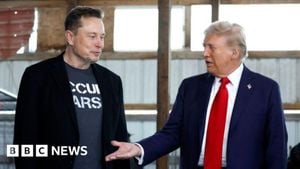The global economic outlook for 2025 reveals a complicated picture as rising interest rates and inflation present both challenges and opportunities for various sectors, particularly the automotive industry. Despite uncertainty driven by geopolitical factors and fluctuated commodity prices, economic analysts are attempting to forecast how these elements will interact and shape the economy moving forward.
According to reports, inflation is set to rise again due to increases in energy prices, particularly gas and electricity. The economic situation has caused concern among governments and businesses alike, as higher inflation correlates with decreased consumer spending and investment. Italy's GDP is forecasted to show slight growth following stagnation in the last quarters of 2024, but the impacts of amplifying costs remain to be seen. "The inflation rate is creeping up again, fueled by increases in gas and electricity prices," noted one economic analyst. This statement highlights the broader concern across Europe, where energy costs have surged amid global supply chain issues.
The cost of electricity and gas has more than doubled, which compounds issues for households and businesses trying to navigate these economic waters. The average price of gas reached 53 €/MWh by February 2025, up from 49 €/MWh just the previous month, showcasing the rapid changes consumers are forced to contend with. Electricity prices are closely tied to gas pricing; for example, the price at the Italian PUN (the Italian electricity market price) rose to 155 €/MWh from 143 €/MWh, which mirrors the European trends highlighted.
Since early 2025, the European Central Bank (ECB) has continued to cut interest rates to mitigate inflation's hold on the economy. A cut of another quarter-point brought rates down to 2.75%, following initial rates of 4%. Analysts expect this trend to continue, with potential for more cuts later throughout the year. Nevertheless, real estate prices across Europe have shown resilience even as consumer demand for loans has declined—businesses find themselves grappling with reduced access to financing even as rates decline.
Investment trends give mixed signals about the economy's health. While there was slight recovery in consumer confidence as retail sales showed some modest gain at 0.8% before the year’s conclusion, broader economic indicators are disjointed. We are seeing challenges within the automotive sector, which experienced significant downturns—with vehicle production marked by staggering losses of 36.6% year-on-year as reported. This collapse not only reflects difficulties faced by manufacturers but also clues to broader consumption trends indicating the weaknesses consumers may be feeling financial stress.
On the other hand, the employment sector appears sluggish. With growth only recorded at 0.5%, worker productivity seems to be stagnated under current conditions, raising questions about wage growth and overall living standards. "The economic indicators suggest meager growth within the industrial sector," warned another economic analyst, pointing out the connection between these numbers and consumer spending.
The impact of policies such as the potential introduction of U.S. tariffs raises more concerns about future export capabilities and competitiveness within the global market. "Possible tariffs have significant consequences on trade and investment, and that's concerning to us as analysts," they added. With trade tightropes affecting monetary policy decisions and potential investment hurdles, many anticipate tough conversations for the automotive sector, which relies heavily on exports to sustain growth.
The situation grows increasingly complicated as analysts assess international trends, including developments across Asia and the Americas. The U.S. economy itself contrasts sharply with Europe; here, economic activity showed unexpected gains yet simultaneous drops were seen within retail sectors. Experts labeled this dissonance as concerning, emphasizing the challenges businesses face as they navigate shifting consumer sentiment.
China's latest figures mirror these woes as industrial production slowed, and consumer growth stagnated. With these fluctuated global dynamics impacting each other's fates, one must ask—how intertwined are these economies? The interplay between diminishing energy costs, tariffs, currency fluctuations, and climate policies creates uneven playing fields across the globe.
Returning to the automotive sector—an industry often regarded as the backbone of many economies—we note its struggles are compounded by rising material costs and must adapt to tightening regulations if it is to stay competitive. Tightened environmental standards mean manufacturers are continuously innovated about clean technology without necessarily having the financial capacity to do so. Such adjustments culminate greater challenges when the purchasing power of consumers declines amid rising costs.
The mixed results trend appears underlined by the necessary rapid adaptations industries must embrace. Reports suggest some companies are cautiously investing again—investments derived from technological shifts toward greener products and processes are underway. "Our outlook for certain sectors, such as the automaker market, remains cautious, yet hopeful through innovations," indicated one industry analyst, who remains watchful for the possible returns on investments aimed for future growth.
The data alludes to potential shifts within economic growth prospects largely dependent on consumer behavior. Even as investor confidence levels fluctuated, the direct correlation between stock market performance and GDP growth raised eyebrows; effectively, with stock prices soaring yet actual economic activity faltering—can one truly believe current stock market highs reflect genuine prosperity?
A cautious optimism remains for 2025 as businesses and governments attempt to maneuver through rising inflationary pressures. The intertwined fate of consumer behavior, energy market volatility, and international trade uncertainties suggest this year will be defined by reactive strategies rather than proactive planning. For the global economy, particularly the automotive sector, the key will lie within adaptability, innovation, and managing stakeholder expectations amid these significant transition phases.



